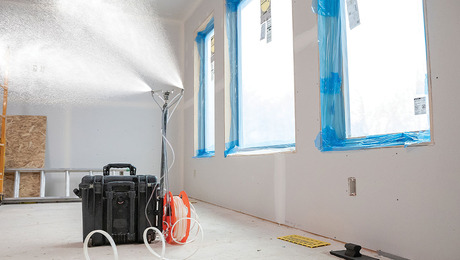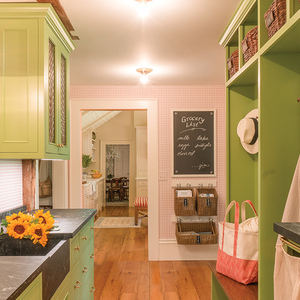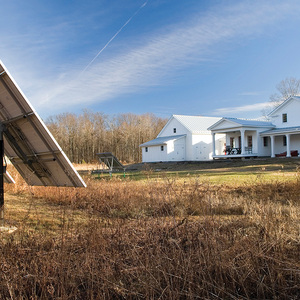Am looking at a possible rebuild of a home that was recently destroyed by a fire. The shell is still standing but will soon be demo’d. House was 2 story gambrel with ~24 x 36′ footprint. Full basement with poured concrete walls.
The hope is to rebuild on the existing foundation. Prior to the fire, there were no issues with the foundation, no cracks, leaks, etc., however, I am concerned that by removing the house, there will nothing to offset lateral stresses on the foundation due to soil pressure.
Am I nuts thinking that the foundation walls need to be braced before the house is demolished?
If so, my next post will be seeking suggestions on how to do this among charred ruins.



















Replies
I think you are worrying too much. ICF foundations are poured before a floor is framed, a floor is poured and are not braced and they are OK. Your foundation is thoroughly cured, the soil has had a chance to stabilize, etc. Free advice with no warranty.
How do you plan to demo?
By hand, probably OK but be carefull of long walls
By machine, better plan on new foundation
Why do you think that? If the foudation is okay'd by an engineer, it will hold up fine if equipment is driven around it. Bob's next test date: 12/10/07
I dont see any problem with driving AROUND it, But one wrong move with the bucket on an excavator or such like can easily take out a wall. I probably was a little heavy on that statement, i only meant : be carefull,damage could easily be done to that foundation
I doubt you'll have any problem with the foundation remaining intact, unless it was weakened by the intensity of the fire.
I'd have a fire investigator or engineer with expertise in fire damage check it out.
Solar & Super-Insulated Healthy Homes
Typically it is unwise to backfill a foundation until at least the first floor deck is on, better yet some more weight than that.
Driving heavy equipment around an unbraced or built on foundation is not something I would consider doing.
It can't hurt to brace it. How much could that insurance cost?
yourcontractor@aol.com
RedfordHenry,
I've seen several homes demo's off of block walls.. Using telehandlers They've lifted the old house off the foundation Dropped them into the basement then tossed the shattered pieces into a dumpster.
Using care to unbolt the sill plates before lifting they didn't even pull a single block apart.. the one I saw who tried to pry the house off the foundation without unbolting the sill plate did manage to loosen a few blocks but I suspect that a poured wall wouldn't have failed.
i had friend that house burned and they left the foundation. they came in with a exavtor with a thunb on the bucket and just started picking the house apart. but they left the floor system completely intact until everything else was cleaned off and gone.
then the operator used that bucket to slowly demo the floor,almost as gently as if you went in there with a crowbar. those guys can wipe a babies but with with no problem if thier good. larry
if a man speaks in the forest,and there's not a woman to hear him,is he still wrong?
I agree with Eric. If you don't brace the foundation walls, it MIGHT be ok. But if not, you're screwed.
Check with a building engineer and plan on bracing the walls. It can't hurt.
Can't answer to the soil issue but I recently tore down a house with a crawlspace (grade under house and grade outside at the same elevation) and we wanted to save the foundation and rebuild on it for setback purposes.
I had the demo guy cut all the anchor straps before he razed the walls. Everything came off the foundation very nice. Couldn't have worked better.
Runnerguy
If so, my next post will be seeking suggestions on how to do this among charred ruins.
We are currently roofing a fire rebuild on the existing foundation. I didn't witness the teardown, but if I can remember, I'll ask the super how they did it tomorrow. I was curious myself. There's lots of fountains, water features and marble paving around the house. All of that has been box framed and covered with plywood. A telehandler would not have been able to access more than maybe a third of the structure for demo. I'm guessing they used a crane.
http://grantlogan.net/
Today we's learnin' about rawks. They's all kinds of rawks. These [picks up rock] is rawks which you throw. These here [throws rock at Rusty] is rawks that you get hit with. E.Cuyler
you need a demolition contractor with one of these and a lot of experience with it. we do this all the time. we have often seen excavators trying to do demo work that don't know what they are doing and they scrape all heck out of the floor and walls with bucket teeth. all it takes is a careful operator.
View Image
carpenter in transition
timkline,
While an excavator with a thumb will work, getting it on site might be expensive compared to having a telehandler do the job..In addition you can use a telehandler to frame and build the house which you can't do with a excavator.. If you've had much experience using them you will be amazed at how carefully you can use the hydraulics to pick apart a house.
A really skillful operator will be able to pull individual boards off the walls. I've used excavators and telehandlers and operating a telehandler is far more intuitive than operating an excavator.. (besides the two different operating systems that excavators have compared to the far more standard controls on a telehandler)...
a telehandler, you mean like an all terrain forklift ?
great for framing, but I never heard of anyone using one for demo.
i guess it would be possible.
carpenter in transition
timkline,
Depending on where you are Lull is probably the most common name, Gradeall is common on the west coast.. They are telescopic or shooting boom forklifts that lift up to 56 feet into the air and 35 feet out in front of the front wheels.. JLG bought out most major players recently and they are becomeing much more common.
(best, easiest ,most stable brand is Ingersol Rand)
Well, telehandlers are the best tool for everything, except applying shellac.Ok, for shellacking too. ;-)
Bracing is done with some blocking (2x10's) hilti'd into the wall and then diagonal 2x's criss crossed on the wall over 4' above the slab.
If the steel did not get hot and is going to be re-used (did the 1st floor deck burn thru?) then the steel beam if the house has one will help keep the walls where they are.
If you run equipment up against a house with clay soils and esp. real wet clay soils, you can put a lot of pressure on the wall and cause it to push.
With that said, I have built, or overseen the construction of hundreds of homes with full foundations and I will not send a framer onto the house prior to it being backfilled. I believe it to be irresponsible and unnecessary risk. There is enough risk taken framing a house, no need for me to add to it.
So I think you can carefully, with an excavator and a thumb, rip the thing apart and build anew, so long as your excavation contractor is sharp, doesnt track along the foundation (they never should) and uses his boom to reach without running up to the wall. (he will likely do anyway cause you cant rip a house apart with a machine when you are a foot away)
Here is a pic of one method of bracing basement walls. Doubt you would want to go buy the brackets for a one time use, but you could probably rig something up that would serve the same purpose... It's the long walls that need to be braced.
That's an interesting set up. I wonder how the engineering would shake out on it. Bob's next test date: 12/10/07
Call me crazy, but why not take some careful measurements and check it as you rip up the floor? My guess is it won't budge, but if it did, you'd know early before any real damage was done.
Beer was created so carpenters wouldn't rule the world.
If the floor is still attached, I' wouldn't worry too much about the walls caving in. If the floor is trashed and I was worried about the walls caving in, I'd get the engineering report and probably add bracing as needed. I don't think it would that hard to brace it but I am not sure how much debris would actually be in the way. I'm thinking it would be substantial but a guy with a power saw could hack his way and create a way to brace in a couple hours. We're basically discussing about $500 worth of labor and lumber for braces. To me, it's not really a discussion. The lumber will be used later for the headers anyways... Bob's next test date: 12/10/07
Personally, I'd still rather demo a strip of floor from side to side and simply take some measurements.
If you brace the walls how will you know if the bracing is working unless you take the careful measurements anyway?
Beer was created so carpenters wouldn't rule the world.
Don, I've never considered using measurements to guage movement on a basement wall. It's just not something I'd be worried about, nor would I measure it. I guess we are just different in that way. I would be watching for cracks, leaning etc, but even then, I probably wouldnt be that concerned if the engineers told me not to worry. Has the OP mentioned if this is a poured wall or block wall? Bob's next test date: 12/10/07
Ok, let's say you take measurements.Then rip down the house.And the measurements have changed.Now what? Break the seal on the foundation waterproofing, and that's screwed. Bowed walls, what are you going to do?Knowing that you've screwed up may be half the battle, but it's only half.
I'd look for a leak, then dig outside and waterproof it. It might run me $1k. Bob's next test date: 12/10/07
Ok, let's say you take measurements.
Then rip down the house.
And the measurements have changed.
Now what?
The idea is more like take a few measurements, rip down the house other than first floor deck, check the measurements, take off half the deck, check the measurements, take off the rest of the deck, check. My guess is nothing will change unless the foundation is #### to begin with, there are long sections of wall with considerable soil pressures, or someone thinks it's ok to park a 30k lb forklift next to the wall.
If during the process you see a little movement it's easy enough to shore up the walls and proceed.
By the time a visible crack has been made the wall has moved considerably!
I honestly don't understand the reluctance to take a simple measurement or at least string a line since it takes very little time and you'll actually know what the foundation is doing, not just a WAG.
Beer was created so carpenters wouldn't rule the world.
I agree with taking measurements and stringing a line. You are correct that knowing what is going on rather than guessing is better.I just don't think waiting until something happens is a good idea. Try and brace it first.
If it's really questionable I agree with you that both bracing and a string line/measurements is a good insurance policy.
Fortunately, or unfortunately depending on how you look at it, the old stone foundations we work with in the historic district can be pushed over by hand once the weight of the house is off, so we never have a question of whether to reuse it or not. *chuckle*
Good building!
Beer was created so carpenters wouldn't rule the world.
Break the seal on the foundation waterproofing, and that's screwed. Bowed walls, what are you going to do?
You think 1/8" of wall movement is going to do that?
Beer was created so carpenters wouldn't rule the world.
The other thing would be to call some experienced excavators and see what they think. Like I said, we backfill poured foundations with no slab, no floor, and no bracing with no problems. Excavators will have experience with local conditions and might have better advice than a bunch of strangers on the internet.